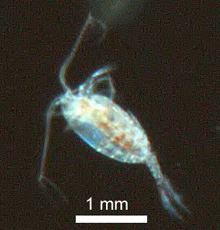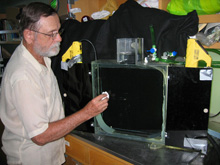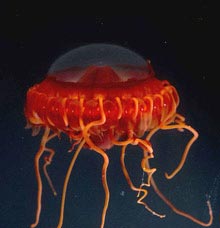Bill Hamner wipes water drops from his traveling planktonkreisel. The black wings (seen on either side) shield the viewer from the glare of the yellow-handled lights mounted behind them. The wings fold over the front panel to protect it when it is packed for travel. The water level is half way up the chimney above the viewing chamber.
Using Planktonkreisels for Ocean Exploration
October 12, 2007
William Hamner
Professor Emeritus
University of California, Los Angeles
![]() Celebes Sea midwater sample collection at 2,800 meters (9,186 feet).
(Quicktime, 1 Mb.)
Celebes Sea midwater sample collection at 2,800 meters (9,186 feet).
(Quicktime, 1 Mb.)
![]() Scientists carefully capture a delicate red Atolla jellyfish.
(Quicktime, 912 Kb.)
Scientists carefully capture a delicate red Atolla jellyfish.
(Quicktime, 912 Kb.)
The ocean is a foreign environment to humans. Although we can swim in the upper reaches of the sea, the midwater environment of the ocean and the deep sea can be investigated only remotely via tools designed for specific purposes or by humans encased within the confines of deep-sea submersibles. Because there is such a great diversity of sizes and kinds of organisms in the sea, our sampling tools also must be varied. We cannot see copepods with binoculars; we cannot catch whales with a plankton net. Accordingly, for our ISSP explorations, we are using a variety of samplers to describe the major components of the Celebes Sea.
Other logs and essays have described most of the tools and techniques we are using — fine-meshed bongo nets and coarser meshed MOC-10 nets, bluewater scuba diving, the in situ video plankton recorder (VPR), and the digital holographic imaging (DHI) system, the remotely operated vehicle (ROV), and the RopeCam. At the sea surface, marine mammalogist and conservationist Dr. Greg Stone documents the presence of marine mammals such as sperm whales, using binoculars, while pelagic seabirds and fish aggregating devices (FADs), floating rafts of debris tied together to attract tuna, attest to the presence of epipelagic fishes in the Celebes Sea. In the laboratory Dr. Russ Hopcroft uses state-of-the-art microscopy to image small zooplankton, while Madin and Hamner study macroplankton collected by scuba divers or by the ROV in a planktonkreisel, a shipboard aquarium designed to display undamaged gelatinous animals.
In the 1960s Dr. Wolf Grève, a German oceanographer, invented an aquarium that circulated water in a horizontal circular pattern. He called his tank a kreisel, a German word for carousel. Inspired by his design, I built a vertical plankton "merry-go-round" that allows researchers to more easily observe animals within the tank. (My planktonkreisel design is explained in detail in the article, Hamner, W. M. 1990. "Design developments in the planktonkreisel, a plankton aquarium for ships at sea." Journal of Plankton Research, vol. 12: 397-402.) Water enters and exits the kreisel through screens at the top to spin slowly in a vertical circle, moving delicate jellies into the center and away from the abrasive edges. Water exiting the kreisel passes through an external filter before recycling into the tank.
To maintain plankton collected in the deep sea or polar oceans, the water also goes through a chiller to keep the kreisel at the temperature to which the animals are adapted. I added a small chimney at the top to prevent water from sloshing out of the kreisel when the ship rolls. The kreisel is filled with water and the only air/water interface is the small surface area inside the chimney. Water doesn’t spill out and air bubbles (that would damage the delicate tissues of gelatinous plankton) don’t get mixed into the tank. The back panel of the kreisel is black and we light the tank through its clear sides, so that its lovely inhabitants glow like Christmas tree ornaments.
This lovely red medusa, Atolla gigantea, about 15 centimeters in diameter, was collected in midwater by the ROV and photographed in the bigger kreisel. When a species like this is caught with a net, its soft gelatinous tissue is shredded by the net fabric or squashed by other captured animals, and the tentacles are torn off. This beautiful red color is common among mesopelagic “jellies” because it isn’t visible in the perpetually dark water, yet it masks any bioluminescence emitted by prey inside the pigmented predator’s gut.
I first used the planktonkreisel to investigate Antarctic ctenophores aboard ship in the rough seas of the Antarctic Ocean. The planktonkreisel has become a standard tool aboard oceanographic ships for watching and filming delicate oceanic animals that are not adapted to a "world within walls." Public aquariums now widely use variants of this design to display jellyfish and ctenophores. Aboard ship in the Celebes Sea, we have two planktonkreisels — a small one about 38 centimeters (cm) in diameter and a larger one, 70 cm in diameter — to house captive gelatinous plankton of various sizes. The two kreisels have been heavily used on the cruise for investigating live zooplankton. They are popular with the team. After a new animal is placed in the kreisel, it is almost impossible to get a glimpse of it through the crowd of biologists and photographers maneuvering for a place to stand where they can look at it. Still images of undamaged plankton in the kreisel by Michael AW will help us to determine if we have new species or new genera. Video footage by Nick Caloyianis will provide new information on their behavior. After we return home, some of their images will be posted on our expedition Web site so that viewers can share our delight in the beautiful and strange animals we have found in the Celebes Sea.





























